View in other NatureServe Network Field Guides
NatureServe
Montana
Utah
Wyoming
Idaho
Wisconsin
British Columbia
South Carolina
Yukon
California
New York
Western Moonwort - Botrychium hesperium
Other Names:
Botrychium matricariifolium, Botrychium michiganense [in part]
State Rank Reason (see State Rank above)
This moonwort species is known from 25-30 extant sites in western Montana, mostly in Glacier National Park or on National Forest lands. Many sites are poorly documented in terms of population size or are small in size, though several sites have been observed with >100 plants. Many populations occur on roadsides or other similarly open or disturbed habitats. As such, the species is vulnerable to activities such as weed invasion, weed spraying and road maintenance.
General Description
Western Moonwort is a small perennial fern with a single erect frond, 3-13 cm high. It is divided into a sterile segment and a fertile segment. The sterile segment has a stalk 0-4 mm long, and a broadly lance-shaped to triangular blade that is pinnately divided with 1-6 pairs of closely adjacent leaflets (pinnae). The basal pinnae are usually partly to wholly pinnately divided and are larger than the lobed or entire-margined upper pinnae. The fertile segment is 2-3 times as long as the sterile segment and 1-3 times pinnately divided into linear segments that bear the spores.
Phenology
Leaves appearing in mid-spring, dying in early fall. Mature fronds in June-July.
Diagnostic Characteristics
The subgenus Botrychium is a large group of very similar species, many of which have been recently described. A technical manual should be consulted for positive identification. The deeply pinnately lobed basal pinnae help separate this species from most others in our area.
Species Range
Montana Range
Range Descriptions
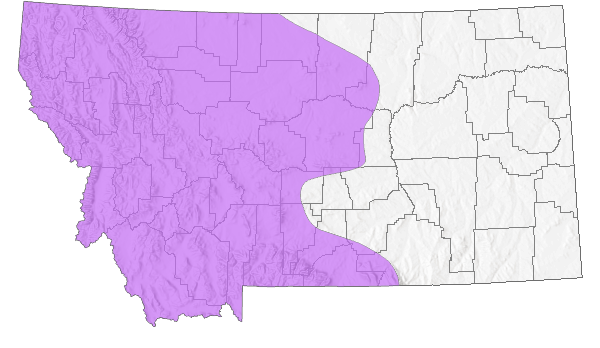
 Native
Native
Range Comments
In MT according to Lesica (2012) in Lincoln, Flathead and Glacier counties, but Farrar (unpublished) indicates a broader distribution across MT ; AK, BC and AB south to WA, ID, WY, UT, AZ and CO (Lesica et al. 2012. Manual of Montana Vascular Plants. BRIT Press. Fort Worth, TX; Donald Farrar (unpublished ms., Iowa State University))..
Observations in Montana Natural Heritage Program Database
Number of Observations: 54
(Click on the following maps and charts to see full sized version)
Map Help and Descriptions
Relative Density
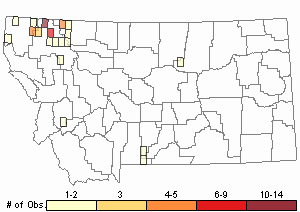
Recency
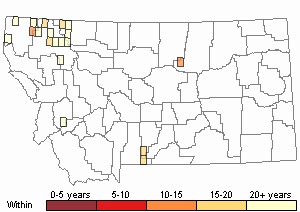
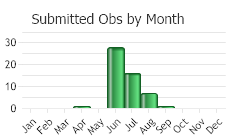
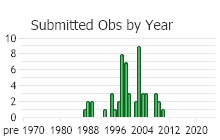
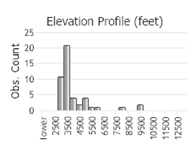 (Observations spanning multiple months or years are excluded from time charts)
(Observations spanning multiple months or years are excluded from time charts)
Habitat
Various dry to mesic sites from valley bottoms to the subalpine, including roadsides and other disturbed habitats. Common moonwort associates include B. paradoxum, B. lunaria and B. lanceolatum. Other moonworts reported at B. hesperium sites include B. minganense, B. adnatum, B. pedunculosum, B. ascendens, B. lineare, B. gallicomontanum, B. pinnatum, B. crenulatum, B. simplex and B. pallidum.
National Vegetation Classification System Groups Associated with this Species
Forest and Woodland
Montane - Subalpine Forest and Woodland
Shrubland
Sagebrush Shrubland
Grassland
Montane - Subalpine Grassland
Wetland and Riparian
Riparian and Wetland Forest
Human Land Use
Transportation
Stewardship Responsibility
References
- Literature Cited AboveLegend:
 View Online Publication
View Online Publication Lesica, P., M.T. Lavin, and P.F. Stickney. 2012. Manual of Montana Vascular Plants. Fort Worth, TX: BRIT Press. viii + 771 p.
Lesica, P., M.T. Lavin, and P.F. Stickney. 2012. Manual of Montana Vascular Plants. Fort Worth, TX: BRIT Press. viii + 771 p.
- Additional ReferencesLegend:
 View Online Publication
View Online Publication
Do you know of a citation we're missing? Ahlenslager, K. and P. Lesica. 1996. Observations of Botrychium x watertonense and its putative parent species, B. hesperium and B. paradoxum. American Fern Journal 86(1):1-7.
Ahlenslager, K. and P. Lesica. 1996. Observations of Botrychium x watertonense and its putative parent species, B. hesperium and B. paradoxum. American Fern Journal 86(1):1-7. Farrar, Donald. 2011. Moonwort (Botrychium) Systematics. Ada Hayden Herbarium. Iowa State University.
Farrar, Donald. 2011. Moonwort (Botrychium) Systematics. Ada Hayden Herbarium. Iowa State University. Lesica, P. and K. Ahlenslager. 1994. Demographic monitoring of three species of Botrychium (Ophioglossaceae) in Waterton Lakes Park, Alberta: 1993 progress report. Unpublished report to the U.S. Fish and Wildlife Service. Montana Natural Heritage Program, Helena, Montana. 19 pp.
Lesica, P. and K. Ahlenslager. 1994. Demographic monitoring of three species of Botrychium (Ophioglossaceae) in Waterton Lakes Park, Alberta: 1993 progress report. Unpublished report to the U.S. Fish and Wildlife Service. Montana Natural Heritage Program, Helena, Montana. 19 pp. Lesica, P. and K. Ahlenslager. 1995. Demography and life history of three sympatric species of Botrychium subg. Botrychium in Waterton Lakes National Park, Alberta, Canada. Draft manuscript prepared in cooperation with Waterton National Park, U.S. Fish and Wildlife Service, and Montana Natural Heritage Program. 22 pp.
Lesica, P. and K. Ahlenslager. 1995. Demography and life history of three sympatric species of Botrychium subg. Botrychium in Waterton Lakes National Park, Alberta, Canada. Draft manuscript prepared in cooperation with Waterton National Park, U.S. Fish and Wildlife Service, and Montana Natural Heritage Program. 22 pp. Lesica, P., M.T. Lavin, and P.F. Stickney. 2022. Manual of Montana Vascular Plants, Second Edition. Fort Worth, TX: BRIT Press. viii + 779 p.
Lesica, P., M.T. Lavin, and P.F. Stickney. 2022. Manual of Montana Vascular Plants, Second Edition. Fort Worth, TX: BRIT Press. viii + 779 p. Mantas, M. and R.S. Wirt. 1995. Moonworts of western Montana (Botrychium subgenus Botrychium). Flathead National Forest. 103 pp.
Mantas, M. and R.S. Wirt. 1995. Moonworts of western Montana (Botrychium subgenus Botrychium). Flathead National Forest. 103 pp. Wagner, Jr., W.H., F.S. Wagner, C. Haufler and J.K. Emerson. 1984. A new nothospecies of moonwort (Ophioglossaceae, Botrychium). Canadian Journal of Botany 62:629-634.
Wagner, Jr., W.H., F.S. Wagner, C. Haufler and J.K. Emerson. 1984. A new nothospecies of moonwort (Ophioglossaceae, Botrychium). Canadian Journal of Botany 62:629-634. Wagner, W. and F. Wagner. 1986. Three New Species of Moonworts (Botrychium Subgenus Botrychium) Endemic in Western North America. American Fern Journal 76 (2):3347
Wagner, W. and F. Wagner. 1986. Three New Species of Moonworts (Botrychium Subgenus Botrychium) Endemic in Western North America. American Fern Journal 76 (2):3347 Wagner, W. H. and F. S. Wagner. 1993. Ophioglossaceae. In: Flora of North America Editorial Committee, eds. 1993. Flora of North America North of Mexico. 3+ vols. New York and Oxford. Vol. 2, pp. 85-106.
Wagner, W. H. and F. S. Wagner. 1993. Ophioglossaceae. In: Flora of North America Editorial Committee, eds. 1993. Flora of North America North of Mexico. 3+ vols. New York and Oxford. Vol. 2, pp. 85-106. Wagner, W.H., and F.S Wagner. 1981. New Species of Moonworts, Botrychium Subgenus. Botrychium, From American Fern Journal 71:20-30.
Wagner, W.H., and F.S Wagner. 1981. New Species of Moonworts, Botrychium Subgenus. Botrychium, From American Fern Journal 71:20-30.
- Web Search Engines for Articles on "Western Moonwort"





